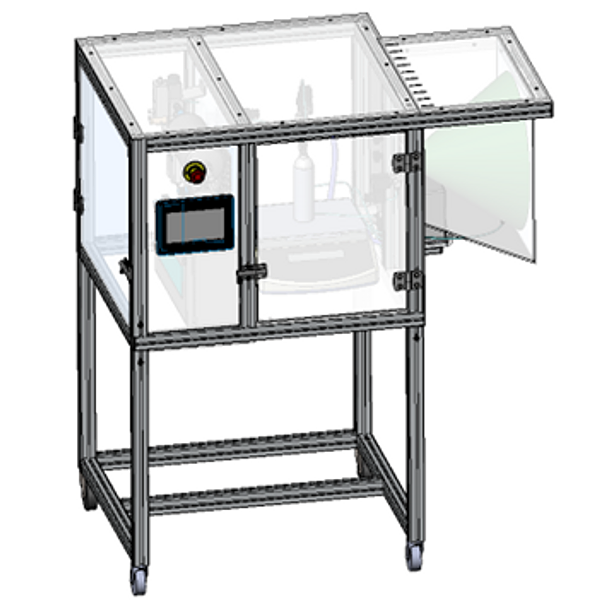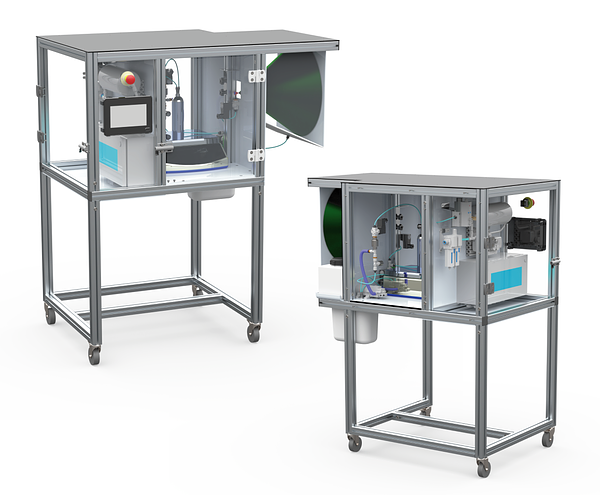Engineering
Teststand sprayventielen
In een eerder project ontwikkelden we een nieuw type sprayventielen voor spuitbussen. Bij gebrek aan een machine werd tot dan toe handmatig een selectie gemaakt om deze ventielen extern te laten testen. Een masterstudent Industriële Ingenieurswetenschappen van de KU Leuven die onder begeleiding van onze ingenieurs zijn masterproef bij ons kwam uitwerken, was dan ook de ideale persoon om zo'n machine uit te werken. Het doel van deze machine was om eenvoudig en efficiënt een preselectie te kunnen maken, waarna de best scorende ventielen alsnog extern getest konden worden.

De geproduceerde ventielen worden extern getest. Aangezien de kostprijs per test relatief hoog ligt, werd echter gekozen om een preselectie te maken om zo enkel de best scorende ventielen nog extra extern te testen. Een preselectie die oorspronkelijk volledig manueel gebeurde.
Aangezien water door zijn hogere oppervlaktespanning de meest ongunstige vloeistof is voor dit type ventiel werd de spuitbus eerst met water gevuld. Na het vullen wordt het ventiel op de spuitbus geperst en wordt het geheel gewogen. Vervolgens wordt gedurende 10 seconden gesprayd, waarna het geheel opnieuw gewogen wordt. Uit beide gewichten kan men het massadebiet op 10 seconden berekenen. Deze test heeft echter heel wat nadelen. Het vergt veel voorbereiding per ventiel dat getest wordt en de spuitbus kan niet hergebruikt worden met als resultaat een grote afvalberg. De nood aan een machine die dit beter en sneller kon was dus hoog. Een student die gedurende een jaar intensief op 1 project werkt en begeleid werd zowel vanuit de opleiding als door onze ingenieurs was dan ook de uitgelezen persoon hiervoor.
Na een literatuurstudie over mogelijke oplossingen en toepassingen kon hij beginnen aan verschillende concepten. De nieuwe machine moest dezelfde drie stappen doorlopen als de manuele testen:
- Een spuitbus vullen met water
- De bus op druk plaatsen
- De spraytest uitvoeren

Naarmate meerdere concepten werden uitgewerkt, kon hij steeds gerichter componenten beginnen zoeken en vastleggen. Zo werden de mechanische componenten zoals de structuur en afschermingen vastgelegd, maar keek hij ook reeds naar de sturing van alle componenten. Hiervoor integreerde hij een PLC en schreef hij al een rudimentaire, eerste versie van het PLC-programma. Om een gebruiker alles eenvoudig te kunnen laten bedienen, werd een touchscreen voorzien waarop de machine eenvoudig bediend kan worden. Daarnaast ontwierp hij ook een HMI-userinterface waarmee enerzijds de machine bediend kan worden, maar waar anderzijds ook de resultaten op af te lezen vallen.
Na het afronden van het ontwerp werd van start gegaan met de documentatie die bij de machine hoort. Dit omvat een handleiding, een risicoanalyse (ISO 12100-1) en de nodige documenten volgens ISO 4414.